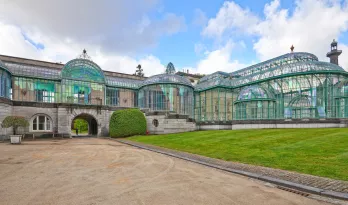The Royal Greenhouses of Laeken in Brussels
The Greenhouses of Laeken are open to the public for three weeks each spring, in keeping with the century-old tradition.

This year, visitors will be able to visit from 15 April to 8 May. Take the Tootbus blue line to visit the Royal Greenhouses by hopping off at stop 4.
In 1873, the architect Alphonse Balat designed a greenhouse complex for King Leopold II to complement the Castle of Laeken. The place has the appearance of a glass city in the park of Laeken with its monumental pavilions, majestic glass and iron domes and wide covered galleries.
Based on the concept of the "ideal glass palace", the Greenhouses of Laeken inspired the new Belgian architecture of the time.
The whole complex has a total surface area of 1.5 hectare and a glass cover of 2.5 hectares, divided into 36 pavilions and organised into 3 zones:
- The monumental greenhouses with the Embarcadère Greenhouse, the Congo Greenhouse, the Winter Garden, the Orangery and the Maquet Greenhouse. They are connected to the castle by the Theatre Greenhouse.
- The Palm Tree Plateau with the Débarcadère, the Palm Greenhouse and the Palm Pavilion, the Iron Church and the Sacristy, the Azalea Greenhouse and the Albert I Greenhouses.
- A series of galleries, corridors, glass passages and small pavilions in between.
During the day, you can choose between two routes that criss-cross the interior and exterior of the greenhouses: a long walk of 2.5 hours and a short walk of 1.5 hour.
The long walk begins with a stroll through the gardens of the Royal Estate, from where you can see the architecture of the greenhouses in perspective. On the way, you will see the ancient ruins of a temple on the edge of a pond, the Japanese Tower and a vaulted rose garden. The greenhouses are visited after the outdoor tour.
The short walk joins the long route and leads into the greenhouses, which house a collection of exotic plants from the original plantations of King Leopold II and contain many rare and valuable plants. During this visit, you will discover the monumental greenhouses and the Palm Tree Plateau.
On Thursday 28 April, there will be special guidance and an adapted 2-hour tour for people with reduced mobility. The visit to the Royal Greenhouses, at 4 euros per person, must be booked in advance online, even for children under 12 years old for whom visits are free.
The Embarcadère Greenhouse
The Embarcadère Greenhouse was built between 1886 and 1887. It was designed to accommodate guests when the King was entertaining in the Winter Garden or in the Greenhouse Dining Room. The greenhouse consists of two longitudinal sections with a barrel vault.
Two statues by Charles Van der Stappen, The Dawn and The Evening, stand at the ends of the Embarcadère. Medinillas (a tropical plant from the Philippines) are arranged in Chinese vases brought back from a trip to the Far East by King Leopold II when he was still Duke of Brabant. A white marble staircase leads to the Congo Greenhouse.
The Congo Greenhouse
The Congo Greenhouse was built between 1886 and 1888. It takes the form of a 30 x 30 m square with an octagonal dome and four small square domes. The greenhouse originally housed plants from the Congo, but they did not stand up well to the lack of light and heat in winter. Today, the greenhouse is home to subtropical plants, including palms from China, Australia and California, and yellow and green ferns. Selaginellas cover the floor.
The Winter Garden
Built between 1874 and 1876, the Winter Garden is the first greenhouse of the Laeken Estate. This greenhouse is topped by a glass dome that is approximately 25 m high and 57 m in diameter. The structure of this rotunda consists of 36 visible cast-iron arches that rest on a Doric colonnade.
Alphonse Balat designed a greenhouse for the planting of high-stemmed plants. The greenhouse is home to subtropical vegetation including huge tree ferns, palms and beautiful strelitzias (better known as birds of paradise). Most of these plantations date from the time of King Leopold II.
The Winter Garden was intended to host royal receptions from the time of its completion. It is linked by glass galleries to the Orangery and the Maquet Greenhouse.
The Orangery
The Orangery was built between 1817 and 1819 by order of William I of the Netherlands. It is a long building in neoclassical style, 97 m long, 13 m wide and 8 m high. In winter, this greenhouse is home to orange trees, camellias and other cold-weather shrubs.
In addition, the Orangery houses the largest collection of camellias in greenhouses in the world with 296 different varieties. This magnificent collection is the result of King Leopold II's passion for camellias.
Castle of Laeken and the Royal Crypt
During your visit to the Royal Greenhouses, take the opportunity to admire the Castle of Laeken. This royal palace is the residence of the Royal Family, which is why it cannot be visited. However, you can see the main façade of the palace.
The Church of Our Lady of Laeken houses the Royal Crypt. This burial place is home to all reigning Belgian sovereigns, their wives and some members of the Belgian Royal Family. The Royal Crypt is only open to the public on certain dates from 2pm to 5pm. We advise you to enquire before your visit.
Continue your visit to the capital in the main districts of Brussels. Discover also our ideas to visit the city with your children.